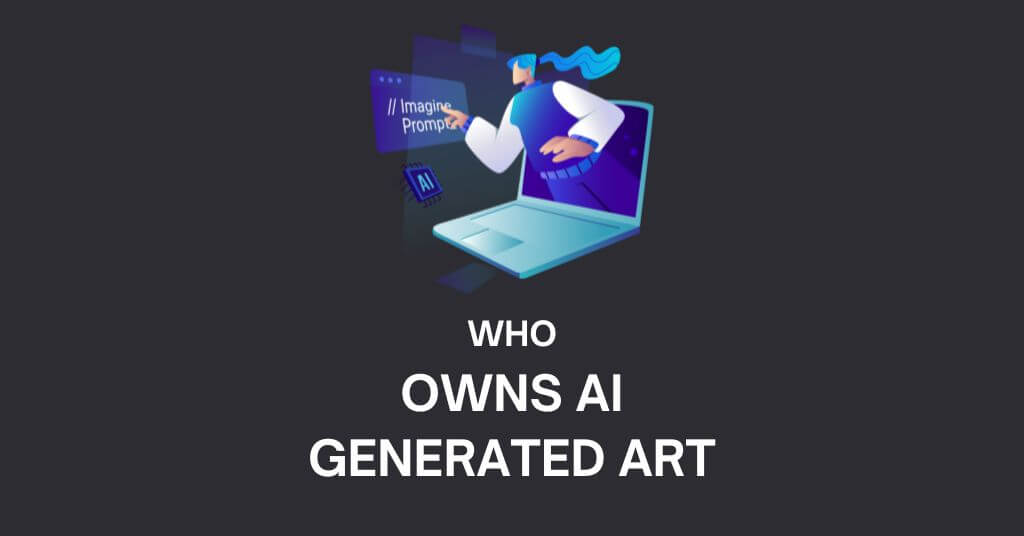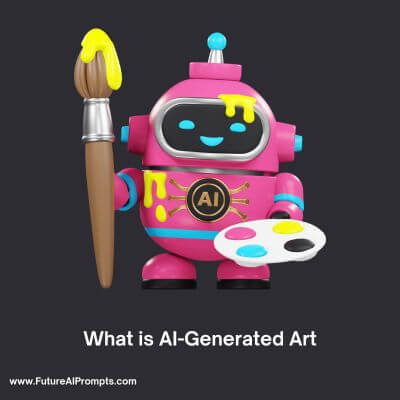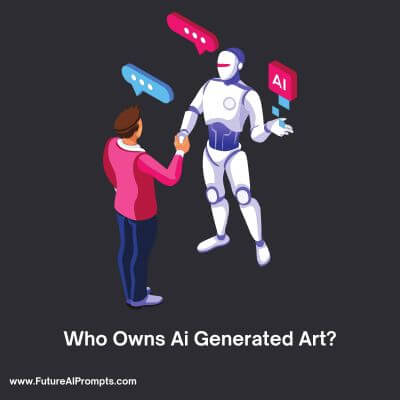Who Owns AI Generated Art: Copyright, Issues and Tips
AI-generated art, a field straddling creativity and technology, has sparked global debates about authorship, copyrights and ethics.
From AI-crafted poetry, portraits and paintings to creating unique images, these innovative creations challenge traditional notions of artistry.
However, ownership of such AI-generated content remains a grey area, raising critical questions about intellectual property rights.
Some companies like Getty Images, have banned AI-created images due to these concerns.
Artists fear such AI developments could undermine their profession and livelihoods.

As we witness an era where machine learning translates prompts into compelling artwork, it becomes super important to establish legal frameworks around AI-generated art, particularly if it’s to be monetized.
The dilemma of who owns AI art, whether it’s fair use or copyrightable, continues to fuel discussion. Let’s discuss this in detail.
What is AI-Generated Art?
AI-generated art, produced by algorithms such as neural networks or generative adversarial networks (GANs), is gaining popularity.
One sub-category is text-to-image generators like DALL-E-2, which create images from text prompts.

Commercial uses of such AI art are expanding, including children’s book illustrations, concept art, newsletters and storyboards.
These systems use vast internet data, including potentially copyrighted content, for training.
AI systems also include image-to-image translators, like StyleGAN and CycleGAN, transforming styles or domains of images and image synthesizers like Artbreeder and BigGAN and generating images from random inputs.
The use of AI-generated art raises legal questions around copyright violations and protections.
Who Owns Ai Generated Art?
The subject of ownership and copyright over AI-generated art is a complex issue that hinges on various factors, such as the degree of human involvement, the originality of the output and jurisdictional laws.
In some instances, human creators employ AI as tools or partners, influencing the claim to ownership.

However, the originality of AI-created artworks is disputable, especially if derived from existing data sets or algorithms.
National laws add further complexity. In the US, for instance, copyright protection extends only to human-created works, denying the possibility of AI-generated creations receiving copyright.
Conversely, in the United Kingdom (UK), original computer-generated works can garner protection. In Canada, the situation remains ambiguous.
While proposed legislation like the Artificial Intelligence and Data Act (AIDA) could regulate certain aspects of AI, it fails to address the copyright issue concerning AI-generated art.
According to the Copyright Act, “original work” refers to the product of an individual’s “skill and judgment”, not mere mechanical exercise.
Certain legal experts in Canada argue that feeding text prompts to generative AI software is a mechanical process that does not result in original work.
However, those proficient in AI art creation understand that formulating successful prompts involves acquired skill.
As it stands, users of generative AI for commercial purposes may lack copyright protection, even when employing “skill and judgment” in formulating text prompts.
Some AI software terms of use may also prohibit users from claiming ownership rights over their creations.
Though ownership typically lies with the artwork’s creator, AI-generated art complicates the situation.
It’s challenging to distinguish which aspects stem from human input and which are machine-generated.
For pure AI-created works, they may fall outside of copyright protection, especially in countries like the US, where works “created by mechanical processes without any creative input” from humans are unprotected.
This complex issue is intensified when considering that AI algorithms often draw from existing human-created artworks to generate new pieces, raising the question of who the rightful owner of AI-generated art is.
Currently, under US Copyright Law, AI-generated art cannot be copyrighted as it does not meet the “original works of authorship” criteria that necessitates a human author.
Consequently, the question of ownership for AI-generated art remains unresolved and a subject of ongoing legal debate.
Issues and Controversies Around AI-Generated Art?
AI-generated art is inciting numerous legal and ethical quandaries, such as potential copyright infringement, questioning of artistic merit and determining responsibility for offensive content.
The grey area between inspiration and plagiarism in AI art has seen artist Kris Kashtanova gaining partial copyright for her AI-produced comic “Zarya of the Dawn”, amidst allegations of similarities to existing online art.

Critics argue that AI art lacks human creativity, prompting debates about its value – exemplified by the $432,500 sale of the AI artwork “Edmond de Belamy“.
Controversially, AI art can contain harmful content, provoking debate about the responsible party: the AI user, developer, or platform host, or even the AI itself.
These dilemmas have reached legal scrutiny. A pending Supreme Court case involving an Andy Warhol illustration of Prince questions the boundaries of ‘transformative’ art under fair use doctrine.
Moreover, Getty Images has sued Stability AI for allegedly using millions of copyrighted images for AI training, initiating similar lawsuits in London and Delaware.
Stability AI and MidJourney face further legal action from three artists seeking a class action.
Thus, AI art presents unresolved challenges in law, ethics and aesthetics.
Tips for Using AI Generated Artwork
Utilizing AI for generating artwork carries risks, necessitating certain precautions.
Refrain from using copyrighted artwork or artists’ names to avoid potential infringement or negative publicity.
It’s important to understand the terms of service and license agreements of AI tools as they dictate the use of generated art, including ownership and content restrictions.
Violation of these terms may result in loss of access or infringement of the tool author’s rights.
Thus, being aware of the limitations and requirements of your chosen AI tool is essential for legally and ethically sound AI art generation.
Frequently Asked Questions about Ownership of AI Generated Art
A: AI-generated art can’t be copyrighted as per the U.S. Copyright Office. The copyright belongs to human creators who program and train the AI algorithms.
A: No, AI-generated art is not protected by copyright according to U.S. law because it is created by machines, not humans.
A: DALL·E 2 can produce images that may infringe upon existing copyrights. However, the liability for such infringement and its consequences remain unresolved.
A: AI-generated work cannot be copyrighted. The U.S. Copyright Office insists work must be human-made for it to be copyrightable.
A: Yes, the U.S. Copyright Office states that AI-generated art is non-copyrightable as it isn’t created by humans.
A: In a case from 2018, where a monkey whose accidental selfie went viral, the U.S. Copyright Office rejected a request to copyright an image created by an algorithm, emphasizing AI-created work can’t be copyrighted.
A: DALL·E 2’s learning process could infringe on copyrights as it involves copying data. Some countries permit this, but the UK has no specific exception. The legal perspective on AI’s data mining for learning remains ambiguous.
I hope this article gave you a clarity about ownership and copyrights of Generative AI artwork.
You can also read more such informational articles in this website about AI.
Also Read: